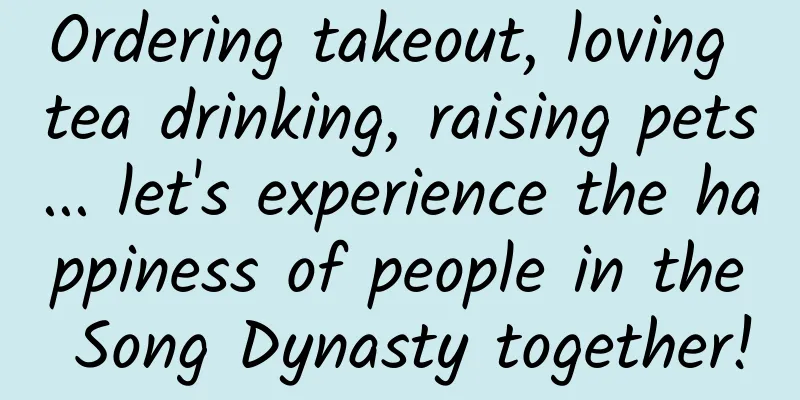Ordering takeout, loving tea drinking, raising pets... let's experience the happiness of people in the Song Dynasty together!

|
What was the Song Dynasty like? In history textbooks The Song Dynasty was an era of poverty and weakness A dynasty that ceded territory several times in exchange for peace but ultimately could not escape the fate of being destroyed A large number of cultural relics show This is also a commercial economy that is extremely prosperous. An era of rising private wealth In this issue, we will take you into The Song Dynasty with its colorful market life Let’s experience their rich life together. 01 Clothing People wearing various costumes|Part of "Along the River During the Qingming Festival" from the Northern Song Dynasty Image source: The Palace Museum official website In the popular TV series "Dream of Splendor", the exquisite costumes and hair accessories of each character are pleasing to the eye, and have also attracted many netizens to pay attention to the aesthetics of the Song Dynasty. For the people of Hangzhou in the Song Dynasty, clothing was indeed given special attention. In ancient times, clothing was not only used to keep warm, but also a symbol of social status. The emperor would also stipulate the etiquette of dressing for different classes. However, in the Song Dynasty, with the development of the commodity economy and the rise of the citizen class, many clothes that were only limited to officials also became popular. The general public would not wear long shirts, but usually only short shirts that reached the waist and light-colored pants. Women wore long robes, short coats, skirts, etc. The materials of the clothes included silk, brocade, and ordinary cotton and linen. The clothing of women in the Song Dynasty|Detail of the "Four Beauties" in the Song Dynasty Image source: Peking University Press official client There are all kinds of shoes in Hangzhou, including leather shoes, wooden or linen loafers, satin slippers, etc. People of status would wear thick-soled boots to make themselves taller. Even very poor people would wear shoes and hats, neatly. Except for monks who walked on the street with bald heads, everyone else would wear a scarf or headdress. Women's decorations have always been rich. In the sunny Hangzhou, women would first put white foundation on their faces, and then apply rose red rouge on their cheeks. Hangzhou women also pay attention to manicures. They would apply impatiens and alum on their nails, and the effect of manicures could last for dozens of days. Women's clothing in the Song Dynasty|Detail of "Yaotai Buyuetu" Image source: The Palace Museum official website They would wear hairpins and combs on their heads, and headbands and earrings were also common. Some women would even wear more than 20 combs on their heads at the same time. However, women in the Song Dynasty no longer tied their hair high on the top of their heads like women in the Tang Dynasty, but combed it back into a bun. In addition, women like to apply hair oil on their heads to make their hair smooth and moisturized. A young woman pursued fashion and accidentally tried the new oil. As a result, she found that her hair began to stick together and had to cut it off. As for eyebrows, women would pluck their eyebrows and then draw black lines with pencils. This was popular in Europe before World War II. Clothing of Song Dynasty scholars|Photo source: Huangyan District Museum As for men, in addition to wearing a turban, most people will shave their chins, and only a few will have sideburns and goatees. Soldiers in particular like to use their luxuriant trade hair to show their vitality, so sumo masters in the army all have "fluffy sideburns." Children even shave their hair, leaving only a small braid in front of their heads. Men's clothing in the Song Dynasty | Part of the Southern Song Dynasty's "Welcoming the Emperor" Image source: China Treasure Museum official website As important as the headdress is the belt. Whether wearing a long robe or a short shirt, you always have to wear a belt. Although ordinary people's belts are not very expensive, they often have a purse hanging on them to hold some money, keys, knives, handkerchiefs, etc. Fans are also an ornament used by both men and women. There are two types of fans: one is the Chinese-style fan, which is round, hard and made of white silk; the other is the folding fan introduced from Korea in the Song Dynasty, decorated with paintings and calligraphy. 02 Food Ceramic molds for snack stalls in the Song Dynasty | Image source: Kaifeng Museum Kaifeng Municipal Bureau of Culture, Broadcasting, Television and Tourism The variety of food in the Song Dynasty is far beyond our imagination. The Song Dynasty is the period when Chinese cuisine was founded. Most of the current cooking terms come from the Song Dynasty, such as stir-fry and deep-fry. At that time, Hangzhou was full of special restaurants, hotels, teahouses, and even stores called "tea and wine chefs" that specialized in providing weddings, funerals and other banquets. Some restaurants sold all frozen dishes, including fish and soup. Some restaurants would specialize in a certain type of food or local dishes. Historical records show that there were hundreds of dishes at that time. Although many of the names seem difficult to understand, judging from the seasoning and cooking methods, the cooking methods of Hangzhou cuisine at that time were not much different from ours now. It's just that the dishes at that time seemed to be more colorful than they are now. Song Dynasty portrait bricks | Image source: CCTV News Hangzhou in the Southern Song Dynasty was particularly populated by refugees from all over the north, which led to the integration of food traditions from all over the country. In the Hangzhou area, 18 kinds of lentils and soybeans, 9 kinds of rice, 11 kinds of apricots, and 8 kinds of pears were planted. Almost every kind of fruit and vegetable had a large number of variants, which naturally made people's food very rich. Moreover, a wide variety of food could be bought in Hangzhou's markets: freshwater fish caught from lakes and rivers, sea fish caught from Zhejiang Bay, game hunted from the mountains south of the city, vegetables grown in gardens, rice harvested from the plains, ducks and geese from the lake area, and pigs and dogs shipped from surrounding areas. Ordinary lower-class people mainly ate rice and pork, and salted fish and animal offal were also popular. At that time, Quzhou restaurants provided food for the lower-class people, including "shrimp, fish, rice noodle soup, fish noodles, butterflies, etc.", and there were always vendors selling cooked food and snacks in the city. Song Dynasty Jun porcelain Arhat bowl|Photo source: Kaifeng Museum Kaifeng Municipal Bureau of Culture, Broadcasting, Television and Tourism Hangzhou had special markets for vegetables, fish, crabs, olives, and oranges, so we can imagine the rich scenes on the dining tables. Some teahouses "sold exotic teas and soups in all seasons, adding Qibao Lu tea, Sanzi, and green onion tea in winter, or selling salt and soy sauce soup, and selling snow-soaked plum blossom wine or spleen-reducing summer medicine in summer", which also shows that the food at that time was exquisite and rich. In addition, "takeout" actually appeared in the Song Dynasty. In the novel "Zheng Jieshi Ligong Shenbigong", there is a description of takeout: an idle man, a basket, a knife, and a few pieces of beef are delivered to the customer and cut in front of him. This phenomenon was very common in the Song Dynasty. In Tokyo, all those who sell cooked food use strange words to sell, so that the food can be sold quickly. The use of coal also promoted the innovation of stoves in the Song Dynasty. The stoves could be moved and sold anywhere, and the fire was always strong. The winter in the Song Dynasty was very cold, and the temperature dropped below zero at night, but tea was still sold. Without a way to keep warm, takeout would not be possible. The delivery man delivering food in the lower right corner|Part of Along the River During the Qingming Festival Image source: The Palace Museum official website The image of "delivery man" can be found in "Along the River During the Qingming Festival" - if a restaurant waiter does not provide good service and is given a "bad review" by a customer, he will be scolded by the store owner, or have his salary deducted or be fired. "If there is a mistake, the guest will report it to the host, who will scold him, or fine him, or even kick him out." As for tea wine, wine was already popular among the rich at that time, but Hangzhou people preferred to drink rice wine brewed by themselves. Rice wine is indispensable for meals. According to records, there were at least 54 kinds of rice wine sold at that time. Their delicious taste was enough to make Hangzhou people lose interest in wine. Tea is also a daily beverage. Hangzhou has three kinds of tea: Zhu tea, Xianglin tea and Baiyun tea. However, tea is also transported into the city from places like Central Plains and Sichuan. Ordinary people buy tea from street vendors for only one penny per bowl. Drinking tea frequently also indirectly makes Hangzhou people drink boiled water frequently, which reduces diseases. Southern Song Dynasty "Chasing Tea"|Photo source: National Palace Museum, Taipei The Song people loved tea-drinking competitions, which were a way of judging the quality of tea and tea soup by brewing tea. To brew tea, you pour boiling water over some matcha and use a bamboo whisk to whisk it until it foams. The tea-tea competition is about the tea soup, whether the color is pure white, whether it can be preserved for a long time, etc. In addition, the tea cups selected for the tea-tea competition are also very particular - Jianzhan uses local porcelain clay with a very high iron content, and is fired to produce a black iron body, which makes a metallic sound when knocked, hence the name "iron body". The body is thick and hard, and contains tiny pores. In the tea-tea competition, it can not only highlight the pure white of the tea soup, but also is more suitable for keeping the tea soup warm. Therefore, it was regarded as "an indispensable and superior tea utensil" by the Song people, and even the emperor strongly recommended Jianzhan and selected it as the imperial tea utensil. 03 Living A partial view of Along the River During the Qingming Festival|Source: The Palace Museum official website Like many big cities today, Hangzhou at that time also had problems such as overpopulation. Many citizens could only live in multi-story houses, and only the rich could live in luxury houses in the mountains on the edge of the city. The houses in the slums were usually very deep, with shops or handicraft workshops on the ground floor. Citizens had to pay rent regularly to the building and store service established by the state. Because of the large population, which can easily lead to epidemics, in Hangzhou, the authorities regularly clean up the streets and clear the canals every year. The rich usually have pit toilets, but the poor living in multi-story buildings in the poor areas can only use mobile "toilets". Cleaners come every day to take away the feces in the toilets, which can be used as fertilizer for the surrounding gardens and vegetable plots in the eastern suburbs. Interestingly, these cleaners have an agreement among themselves. They regard excrement as an important resource. “Each has its own customer, and they dare not steal it. If they do, the owner will fight with them, and even go to the government for a big lawsuit, and they will not stop until they win.” In the Song Dynasty, bathing became a popular activity for the public instead of the nobility. People could bathe at home, and many people had a special bathing space in their homes. Public bathrooms also began to emerge in the market. The clean and elegant Song people called the bathhouse "perfume shop". If you walked in the streets of the Song Dynasty and saw a pot hanging at the door, it was a perfume shop. In the Song Dynasty, scholars who did not bathe for many years would be laughed at. There was a man named Dou Yuanbin, who came from a famous family and was very talented, but because he did not bathe often, his colleagues called him "Dou Chou". There were many bathhouses in Hangzhou, and basins were hung at the entrances of the bathhouses as a sign. According to Marco Polo, there were probably more than 3,000 such commercial bathhouses in Hangzhou, each of which could accommodate 100 people bathing at the same time. Bathhouses at that time not only provided massages, but also provided tea, wine and other services. Unlike us, most people at that time liked to take cold baths, and special hot water baths were provided for foreigners who could not stand cold water. In the Song Dynasty, keeping cats at home became a popular fashion. If a person in the Song Dynasty decided to keep a cat, he would often choose an auspicious day, bring a "bride price", and go to the door to "engage" the cat. In the ancient ritual system, "Book of Rites: Inner Rules" says "engagement is a wife", and "Da Dai Li Ji: Shengde" says "weddings are used to distinguish men and women and to clarify the meaning of husband and wife". Calling keeping cats "engagement" is enough to show that the Song people have elevated the ritual of welcoming cats into the house to a level that can be compared with family members. The Dongjing Menghualu mentioned that there was a business category specializing in pet food in the market of Bianliang in the Northern Song Dynasty, "If you raise a dog, you will be provided with glutinous rice, and if you raise a cat, you will be provided with cat food and small fish." Menglianglu also mentioned in its "Miscellaneous Goods" entry that in the business of Lin'an in the Southern Song Dynasty, "If you raise a cat, you will be provided with fish and loach." In some wealthy families, cats not only eat small fish, but also very high-end venison. 04 rows A partial view of Along the River During the Qingming Festival|Source: The Palace Museum official website Until the Tang Dynasty, Chang'an still retained the ancient "fangshi system", that is, residential areas and commercial areas were separated by fang walls, and stalls and shops were not allowed on residential streets. In the Song Dynasty, the fangshi system that originally restricted commercial freedom was completely disintegrated. People set up markets along the river and opened shops on the street. A lifestyle with a more commercial and civic flavor, like the long scroll "Along the River During the Qingming Festival", emerged. There were numerous canals in Hangzhou for transportation, and lakes and swamps were everywhere at the time, so residents chose water transportation whenever possible. In order to meet the needs of ordinary people, the government paved many stone roads and rebuilt more than a hundred bridges many times. Panoramic view of Zhouqiao ruins|Photo source: Xinhuanet However, traffic jams still occasionally occur near city gates and bridgeheads, and the alleys in some poor neighborhoods often see porters carrying loads, animals carrying bags, and passers-by crowding and bumping into each other. In addition to the various commercial activities, there were also parks and flower gardens outside the city for citizens to enjoy. During festivals, holidaymakers would flock to these places. Similar to today's tours, many citizens would bring food and musical instruments and hike all day along the lake and in the hills. Some people would spend a few cents to hire a small boat and enjoy the West Lake. From the Tang Dynasty to the Song Dynasty, local officials in Hangzhou paid attention to the maintenance of West Lake. Every building was rebuilt and renovated in an effort to coordinate with the surrounding environment. There are always hundreds of boats on West Lake, including large boats carrying hundreds of passengers, as well as small boats selling vegetables, fruits, chickens, seasonal flowers, fine wine, tea and fruit. In addition, there are also many small fishing boats and boats for releasing animals. It is worth mentioning that the first real traffic law in Chinese history was born in the Song Dynasty. The twelve words "the cheap avoid the expensive, the young avoid the old, the light avoid the heavy, the going avoid the coming" means that when you meet an old man or a person carrying a load on the road, you should give way to them first. In addition, the Song Dynasty also had "speed limit" regulations on speeding. The Song Dynasty Code clearly stipulated that it was forbidden to ride fast horses or drive fast cars in the streets and crowded places in the city, unless it was extremely urgent, otherwise the person would be punished by being beaten with a stick. This shows that the Song Dynasty was full of courtesy and kindness. Source: Chongqing Jiulongpo District Cultural Relics Management Office Audit expert: Li Xiaoying Sources: CCTV News, "Daily Life of Song People" by Hou Yinguo, Phoenix Online Reading, CCTV Documentary "In Search of Different Life in the Song and Jin Dynasties", "Song: Ten Aspects of Elegant Aesthetics" by Deng Xiaonan et al., Sanlian Bookstore, "Song: The Dawn of Modern Times" by Wu Gou, Guangxi Normal University Press, "Eating an Interesting Song Dynasty Banquet" by Li Kaizhou, China Legal System Press, "Daily Life in China on the Eve of the Mongol Invasion" by Xie Henai, Peking University Press, New Weekly No. 500, "Drinking Tea, Drinking Wine, Ordering Takeout: Traveling to the Song Dynasty to Live the Life of Citizens" by Yi Yongwen/Kuang Xinhua Image sources: Photo Network, CCTV News, the Palace Museum, China Treasure House, Peking University Press official client, Xinhuanet, Huangyan District Museum, Kaifeng City Museum, Kaifeng Municipal Bureau of Culture, Broadcasting, Television and Tourism, Taipei Palace Museum Statement: Except for original content and special notes, some pictures are from the Internet. They are not for commercial purposes and are only used as popular science materials. The copyright belongs to the original authors. If there is any infringement, please contact us to delete them. |
<<: Late-night snacks linked to certain cancers? Don’t eat when you’re hungry before bed!
>>: The culprit of premature graying has been caught! Can gray hair turn black again?
Recommend
Eleven ways to make your IT career bottleneck-free
The following eleven highly practical measures ar...
Do you dare to challenge a cup of cockroach milk?
Key Points ★ "Cockroach milk" is not or...
If you want to use iPhone 7 in winter, you have to be careful with the Home button
The new generation of iPhone 7 has caused a lot of...
6 steps of data operation, from methodology to cases to get you started!
Analyzing operational data helps us further perfo...
This wave of "childish talk" really made me laugh to death, but why are childish talk so funny?
As the saying goes, "children speak without ...
WeChat has secretly launched a new feature! Have you discovered it?
A good product is one that is constantly updated ...
Kuaishou short video shooting skills
What we are sharing today are the three shooting ...
Science and Technology Review: Thoughts on the process of automobile intelligence and its key technologies
With the rapid development of Internet technology...
Bidding promotion: How to control ocpc?
We know that currently there are two types of bid...
How much does it cost to be an agent for the Diqing wedding banquet mini program?
How much does it cost to be an agent of Diqing We...
The price of immunoglobulin G has been hyped up to tens of thousands of yuan. Do we really need to stock up some during the peak of the epidemic?
The continued development of the COVID-19 pandemi...
A 10,000-word article details the 7 types and 8 steps for creating 100,000+ titles!
Come, before we get started, let’s do a test to s...
Precise positioning of Moments ads, do you want to know how WeChat sees you?
Do you want to know how WeChat sees you? Since th...









